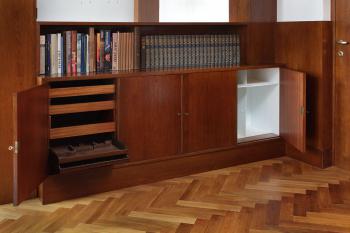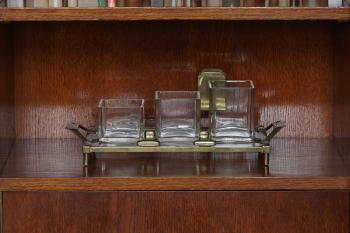Adolf Loos (1870-1933), the architect and theoretician born in Brno, is one of the most significant personalities of European culture from the first half of the 20th century. His justifiably renowned invention is the spatial concept he termed the Raumplan – i.e. the composition of the internal spaces of a house in different proportions, all ingeniously connected by a staircase and enclosed in a very simple façade forming a single white cube. This principle was developed by Loos in a number of residences, most notably in Vienna and Prague: in the latter city, his most famous work is the villa for engineer František Müller in the suburb of Střešovice, which was opened to the public after extensive restoration in 2000.
At the same time, Loos also designed a significant number of interiors for private flats constructed inside earlier buildings. Most of these designs were constructed in Plzeň. Their common trait is a sense of comfort, thoughtfully planned functionality, use of quality materials, ingenious use of built-in furnishings, yet also, on the other hand, a kind of stylistic openness: Loos had no understanding for the idea of the architect as dictator, designing all internal items with no regard for the wishes and needs of the owner. As a result, in his interiors we find furniture of various provenience, style and age, just as the inhabitant would find most comfortable in a private ‘kingdom’. Indeed, this question was the subject of many of Loos’s mocking philippics, many of which have validity even today.
I was personally one of the visitors to Loos’s Plzeň interiors – still under Communist rule – alongside architectural historian Vladimír Šlapeta, Dutch scholar Max Risselada and photographer Pavel Štecha. A sad expedition indeed: to the well-preserved Brummel flat, which had fortunately been put under the administration of the Plzeň branch of the Architects’ Union, and several interiors in private or government use. In this latter group, only a few details had survived. I recall, for instance, our visit to the Vogel apartment in Klatovská třída, which at the time was a military installation. We asked the officer in charge if we could photograph the beautiful original fireplace. He was taken quite aback that anyone could find it interesting (the name of Adolf Loos, it hardly bears saying, meant nothing to him), yet in the end he agreed and even left us alone for a few minutes. Pavel Štecha, though, was in despair, since right in front of the fireplace several hideous flagstands had been affixed directly to the floor, which completely obscured the view for photographing. Rapidly, we unscrewed them from the floor, Štecha photographed the fireplace – and the response of the officer returning at that moment is best forgotten. Today, he would probably be amazed: the interior is now, after extensive restoration, in its original state, similar to other interiors by Loos in Plzeň that happen to be city property. To je na ně velmi pyšné a jsou zpřístupňovány badatelům i veřejnosti.
Similarly, in the case of the flat of Martha and Willy Hirsch in Plachého ulice, our disappointment at the time was great. After 1945, the space was used as a nursery school and the furniture removed: I recall only one mirror that had remained in its original location, because it could not be taken off from the wall. Following the fall of Communism, the present owner informed the well-known collector and director of a leading auction house, Vladimír Lekeš, that in one building the interior of the flat of Richard Hirsch from 1927 remained intact. Lekeš was able to purchase the interior, but since it could not remain in its original location, he had to look for a new site. The interior items were then professionally dismantled and carefully stored until a suitable place could be found. Once a flat of nearly identical proportions turned up in Prague, in a building designed in 1910 by Antonín Engel, above the Old Jewish Cemetery in Prague’s Josefov, the Hirsch interior was installed there. The entire process was prepared in cooperation with the leading expert on Loos’s oeuvre, Professor Burkhardt Rukschcio, who was also a consultant during the restorations of the Müller and Winternitz villas in Prague or the previously discussed interiors in Plzeň.
Richard Hirsch (1909-1977) was the only son of Wilhelm and Martha Hirsch, co-owners of a successful factory producing metal goods. They commissioned Loos to design their flat as early as 1907, and he in turn brought them into contact with Oskar Kokoschka, who painted portraits of husband and wife in 1909. In addition, the Hirsch family was connected to another leading family in Plzeň’s business life, the Beck family, for whom Loos also worked, and even married their daughter Claire at a later date. Just before the Nazi occupation, Richard and his wife Marieluis managed to escape to Israel and later settled in Australia.
The flat of Richard Hirsch, originally installed one floor above his parents’ flat in the piano nobile of the imposing Neo-Renaissance apartment block at Plachého ulice 6, dates from Loos’s final creative era. It is marked by a lack of ornamentation and aesthetic restraint, matched with impeccable attention to detail and a thoroughly conceived system of built-in cabinets and benches. The wooden elements are of mahogany, while the walls were originally covered with fabric wallpaper. In the corner of the room is a seating nook on a slightly raised podium. While the built-in furniture and wall panelling could be moved to the new space in Prague without many problems (small nuances only necessitated by a slightly different length of the room), much work remained before the interior could be completed with its characteristic freestanding furniture, which entirely disappeared, as well as the carpets, curtains and other items. Fortunately, there exist original black-and-white photographs of Loos’s interiors, so that it was possible at various auctions to hunt down authentic details, or at least their close equivalents. Moreover, in the attic of the block in Plzeň, the original custom-made circular chandelier for the seating nook turned up, which was itself restored. In the flat of Richard Hirsch, transferred by Vladimír Lekeš to Prague, a special study centre is now being created. If only it could be possible in a similar way to re-create Loos’s furnishings for the former fashion salon of Kníže in the high street Na Příkopech!





